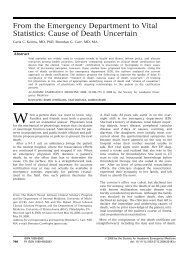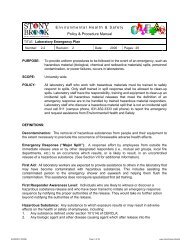Occupational Exposure to Bloodborne Pathogens - Stony Brook ...
Occupational Exposure to Bloodborne Pathogens - Stony Brook ...
Occupational Exposure to Bloodborne Pathogens - Stony Brook ...
Create successful ePaper yourself
Turn your PDF publications into a flip-book with our unique Google optimized e-Paper software.
• people with high-risk sexual behavior, multiple partners and sexually<br />
transmitted diseases,<br />
• people who snort cocaine using shared equipment, and<br />
• people who have shared <strong>to</strong>othbrushes, razors and other personal items<br />
with a family member who is HCV-infected.<br />
How is the virus spread?<br />
Like hepatitis B virus, hepatitis C virus is spread when blood of an infected<br />
person enters the body of a person who is not infected, such as through sharing<br />
needles or "works" when shooting drugs or occupational needle stick injury. The<br />
risk of sexual transmission has not been thoroughly studied but appears <strong>to</strong> be<br />
low in long-term, monogamous relationships. There is no evidence that the<br />
hepatitis C virus can be transmitted by casual contact such as hugging or<br />
shaking hands, through foods, by sharing eating utensils or drinking glasses, or<br />
by coughing or sneezing. Hepatitis C is not spread by breastmilk.<br />
What are the symp<strong>to</strong>ms and consequences of infection?<br />
Approximately 20 percent of persons exposed <strong>to</strong> the virus develop symp<strong>to</strong>ms<br />
which may include jaundice (yellowing of the skin and whites of the eyes),<br />
fatigue, dark-colored urine, s<strong>to</strong>mach pain, loss of appetite and nausea. After the<br />
initial infection, 15-25 percent will recover and 75-85 percent will become<br />
chronically infected (life-long infection). Approximately 70 percent of persons<br />
chronically infected may develop liver disease, sometimes decades after initial<br />
infection.<br />
How soon do symp<strong>to</strong>ms occur?<br />
Symp<strong>to</strong>ms may occur from two weeks <strong>to</strong> six months after exposure but usually<br />
within six <strong>to</strong> nine weeks.<br />
When and for how long is a person able <strong>to</strong> spread hepatitis C?<br />
Persons with acute hepatitis C virus infection are generally contagious from one<br />
or more weeks before the onset of symp<strong>to</strong>ms. The contagious period is indefinite<br />
in chronically infected persons. All persons who test positive should be<br />
considered <strong>to</strong> be potentially contagious.<br />
What is the treatment for hepatitis C?<br />
Drugs (anti-viral) are licensed for treatment of persons with chronic hepatitis C.<br />
Combination drug therapy, using pegylated interferon and ribavirin, can get rid of<br />
the virus in up <strong>to</strong> five out of ten of persons with genotype 1, the most common<br />
EHSD0326 (10/08) Page 6 of 12 www.s<strong>to</strong>nybrook.edu/ehs
















